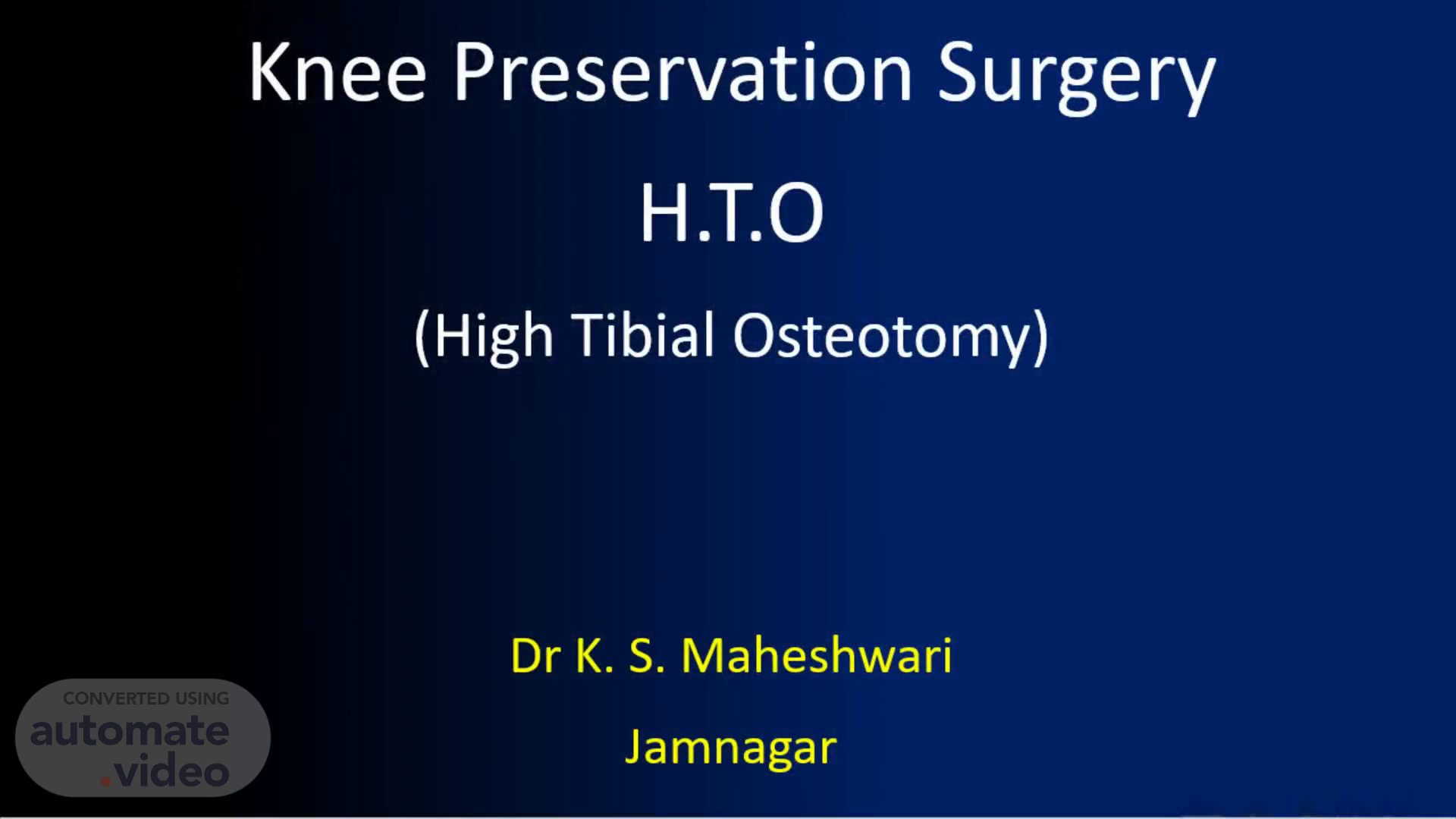
PowerPoint Presentation
Scene 1 (0s)
Knee Preservation Surgery H.T.O (High Tibial Osteotomy) Dr K. S. Maheshwari Jamnagar.
Scene 2 (9s)
What is arthritis? It is a chronic, progressive musculoskeletal disorder characterized by gradual loss of cartilage in joints which results in bones rubbing together and creating stiffness, pain, and impaired movement . prevalence higher than many well-known diseases such as diabetes, AIDS and cancer.12-Oct-2017.
Scene 3 (25s)
Arthritis affects more than 180 million people in India Prevalence of 22% to 39% in India More common in women than men 45% of women over the age of 65 years have symptoms while 70% of those over 65 years.
Scene 4 (41s)
In United States Among adults 60 years of age or older the prevalence of symptomatic knee OA is approximately 10% in men and 13% in women (2)..
Scene 5 (56s)
STAY ACTIVE LONGER More and more people are experiencing knee pain at a younger age as a result of living very active lives. Early Onset Knee Osteoarthritis affects many people involved in sports who have suffered ligament injuries at some point during their lifetime ..
Scene 6 (1m 11s)
Symptoms The predominant clinical of osteoarthritis knee is Pain Joint stiffness Swelling Deformation Symptoms can be from mild to disabling..
Scene 7 (1m 20s)
Stages of O.A.. Doubtful Mild Moderate.
Scene 8 (1m 28s)
Treatment. Doubtful Mild. Stage l &ll. Lifestyle Changes Reduction of Weight Exercises Dietary changes Mild analgesic Glucosamine,Chondroitin sulphate Soft chapples or shoes Knee Braces and orthoses.
Scene 9 (1m 40s)
Glucosamine & Chondroitin sulphate.
Scene 10 (1m 46s)
Soft Chappal.
Scene 11 (1m 52s)
90, 98. Knee Braces.
Scene 12 (1m 59s)
Moderate. Stage lll . Strong Antalgics Injection Steroid local Visco-suppliments ( Injections of hyaluronic acid derivatives ( Hyalgan , Synvisc ) may offer pain relief by providing some cushioning in your knee .) Surgery – H.T.O..
Scene 13 (2m 13s)
DSCF5450. Severe. Stage lV Surgery - Arthroscopy - HTO - unicompartmental arthroplasty - Total Knee Repalcement.
Scene 14 (2m 24s)
Lavage. wash out of debris & inflammatory enzymes ..
Scene 15 (2m 47s)
U nicompartmental arthroplasty. A partial knee replacement—also called unicompartmental knee replacement or partial knee arthroplasty —is a surgical procedure in which damaged bone or cartilage involving only one surface of the knee joint is removed and replaced with metal or plastic part.
Scene 16 (3m 3s)
Total Knee Replacement TKR. K nee arthroplasty or total knee replacement, is a surgical procedure to resurface a knee damaged by arthritis. Metal and plastic parts are used to cap the ends of the bones that form the knee joint, along with the kneecap . The primary indication for TKA is to relieve pain caused by severe arthritis. The pain should be significant and disabling. Night pain is particularly distressing. If dysfunction of the knee is causing significant reduction in the patient's quality of life, this should be taken into account.1.
Scene 17 (3m 31s)
Osteotomies were performed regularly in the half of the 20 th century The breakthrough came with the publication of J ackson, Waugh, Conventry in the late 1950s and 60s. The classic osteotomy of Coventry was a closed-wedged osteotomy and was performed proximal to the tibial tuberosity. This was the widely used technique for a long time.
Scene 18 (3m 50s)
Tvalowo. Tvalowo. Different HTO Methods Closed wedge osteotomy Hemi-closed/Hemi-open wedge osteotomy Open wedge osteotomy Dome-shaped osteotomy.
Scene 19 (4m 1s)
Many fixation devices and implants Staples External fixator TB wire Blade plate, Locking Plate..
Scene 20 (4m 13s)
Younger than 60 years Wishes to maintain an active life style Purely medial OA knee clinically and on weight bearing X-ray. Varus deformity of less than 15 degrees Rom > 120º.
Scene 21 (4m 28s)
Bi- or tri-compartmental joint destruction Lateral OA (clinical results are not predictable) Flexion contracture > 15 degrees ROM of less than 90 degrees Varus deformation of more than 15 degrees Lateral tibial subluxation > 1cm, ligamentous instability Medial compartment tibial bone loss > 5 mm Rheumatoid arthritis.
Scene 22 (4m 45s)
Lateral Close wedge High Tibial Osteotomy Technique (Modified).
Scene 24 (5m 3s)
Surgical technique. Surgical Steps. Fibular Head Excision Wedge Preparation Wedge Closing Staple Fixation Plaster Application.
Scene 25 (5m 18s)
Surgical technique. Supine position AB prophylaxis Tourniquet Fluoroscope from the contra lateral site.
Scene 26 (5m 30s)
Skin incision (about 7 cm). Small incision Good exposure No wound problems.
Scene 27 (5m 41s)
Skin incision. 27. F. H.
Scene 28 (5m 49s)
Skin incision. Expose tibio -fibular joint. 28. coy..
Scene 29 (5m 59s)
Partial fibular head excision. 29. F. H. F. H.
Scene 30 (6m 8s)
30.
Scene 31 (6m 15s)
31. Partial fibular head excision. F. H. F. H.
Scene 32 (6m 26s)
32. Cut the Retinaculum.
Scene 33 (6m 33s)
33. Clear Prox. Tibia Anteriorly.
Scene 34 (6m 40s)
34. Clear prox. Tibia Posteriolarly.
Scene 35 (6m 47s)
First osteotomy. Under fluoroscopic control 2 cm below joint line.
Scene 36 (6m 59s)
Wedge Measurement. 36. F. H.
Scene 37 (7m 6s)
Second guide wire. 37.
Scene 38 (7m 13s)
Second guide wire. 38.
Scene 39 (7m 19s)
Wedge Cutting. 39.
Scene 40 (7m 26s)
Wedge Cutting. 40.
Scene 41 (7m 32s)
Complete the first and second osteotomy with the osteotomies and resect the wedge..
Scene 42 (7m 42s)
Modification - 1. 42. Not in the old technique.
Scene 43 (7m 51s)
MIRR ROTN:230 AVG.•08 X-RAY OFF. Closing of wedge.
Scene 44 (7m 59s)
Staple Fixation. 44.
Scene 45 (8m 6s)
45. Staple Fixation.
Scene 46 (8m 13s)
46. Staple Fixation.
Scene 47 (8m 19s)
47. 020.
Scene 48 (8m 26s)
After Staple fixation. Release tourniquet Haemostasis Drain fixation closure.
Scene 49 (8m 38s)
49. Cylinder cast. Cylinder cast.
Scene 50 (8m 45s)
50. Incomplete.